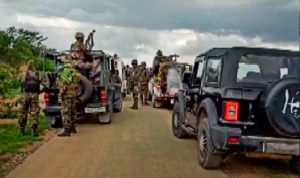18-07-2023
Bureau Report + Agencies
NEW DELHI: Zuan Vaiphei is armed and prepared to kill. He is also ready to die. Vaiphei spends most of his days behind the sandbag walls of a makeshift bunker, his fingers resting on the trigger of a 12-gauge shotgun. Some 1,000 yards (914 metres) ahead of him, between a field of tall green grass and wildflowers, is the enemy, peering from parapets of similar sandbag fortifications, armed and ready.
 “The only thing that crosses our mind is ‘Will they approach us? Will they come and kill us?’ So, if they happen to come with weapons, we have to forget everything and protect ourselves,” the 32-year-old says, his voice barely audible amid an earsplitting drone of cicadas in Kangvai village, which rests in the foothills of India’s remote northeastern Manipur state.
“The only thing that crosses our mind is ‘Will they approach us? Will they come and kill us?’ So, if they happen to come with weapons, we have to forget everything and protect ourselves,” the 32-year-old says, his voice barely audible amid an earsplitting drone of cicadas in Kangvai village, which rests in the foothills of India’s remote northeastern Manipur state.
Dozens of such sandbag fortifications mark one of the many front lines that don’t exist on any map and yet dissect Manipur in two ethnic zones – between people from hill tribes and those from the plains below.
Two months ago, Vaiphei was teaching economics to students when the simmering tensions between the two communities exploded in a bloodletting so horrific that thousands of Indian troops were sent to quell the unrest.
Ethnic clashes between different groups have occasionally erupted in the past, mostly pitting the minority Christian Kukis against mostly Hindu Meiteis, who form a narrow majority in the state. But no one was prepared for the killings, arson and a rampage of hate that followed in May, after the Meiteis had demanded a special status that  would allow them to buy land in the hills populated by Kukis and other tribal groups, as well as a share of government jobs.
would allow them to buy land in the hills populated by Kukis and other tribal groups, as well as a share of government jobs.
Witnesses described how angry mobs and armed gangs swept into villages and towns, burning down houses, massacring civilians, and driving tens of thousands from their homes. More than 50,000 people have fled to packed relief camps. Those who fought back were killed, sometimes bludgeoned to death or beheaded, and the injured tossed into raging fires, according to witnesses and others with first-hand knowledge of the events.
The deadly clashes, which have left at least 120 dead by the authorities’ conservative estimates, persist despite the army’s presence. Villages have turned into ghost towns, scorched by fire so fierce that it left tin roofs melted and twisted.
“It is as close to civil war as any state in independent India has ever been,” said Sushant Singh, a senior fellow at the Centre for Policy Research in India and an Indian army veteran.
 Pressmediaofindia
Pressmediaofindia




